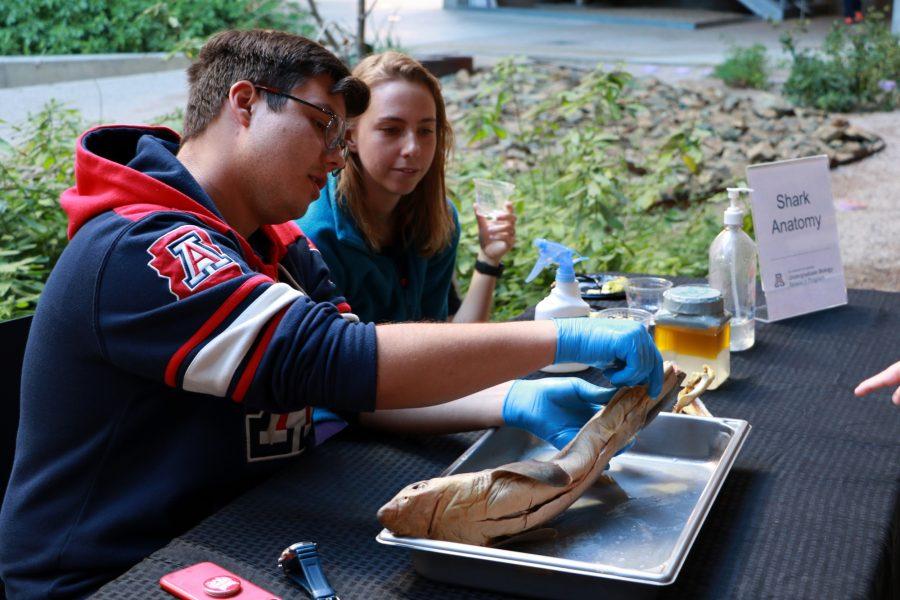Over 100 University of Arizona undergraduate researchers presented their work at the 31st annual Undergraduate Biology Research Program Conference in the Environmental and Natural Resources 2 building on Saturday, Jan. 25. This conference served as a public showcase of the work UBRP students completed during their time in the program.
“UBRP gave me the opportunity to see what it’s like to be a biologist, to be a researcher, to do primary research,” said UBRP student and ambassador Andrew Alamban, a senior studying molecular and cellular biology and mathematics.
According to its website, “[UBRP] is an educational program designed to teach students science by involving them in biologically related research.”
The program is open to all UA students interested in doing research in biology, Alamban said, not just biology majors.
Students are hired as paid research assistants to work throughout the summer. UBRP participants are also able to continue their work into the academic year if they meet certain requirements.
RELATED: Past, present and potential future ‘UBRPers’ gather at the program’s 30th annual conference
“If [students] don’t have a lab yet, the program does help you find a lab. That’s how I found my lab mentor,” Alamban said. “Throughout [the paid internship], students will learn techniques, they’ll generate data and … today, that’s when we get to showcase our findings.”
Through the program, students are also taught strategies of presenting their research to the public.
“We do train our students; we host workshops for them,” Alamban said. “This is in hopes to make them be better science communicators, and [the UBRP Conference] is kind of a way for them to showcase those trainings.”
UBRP students presented their work through posters they designed. Each student also explained their posters to family, friends and anyone else interested in their research.
The event kicked off at 10 a.m. with a presentation by UA alumnus Dr. Oscar Serrano, an abdominal transplant and hepatobiliary surgeon at Hartford Hospital and assistant professor of surgery at the University of Connecticut School of Medicine. He titled his talk, “Disparities in Healthcare: Why Your Inclusion in This Discussion is Critical for the Wellbeing of Your Community.”
In accordance with UBRP tradition, Serrano was introduced by his former UBRP mentor, Dr. William Dantzler.
Serrano participated in UBRP in the summer of 1997, after his freshman year at the UA. He started his research in Dantzler’s lab, where he ended up staying until he graduated.
“UBRP was probably the single extra-academic experience … that got me to where I am today,” Serrano said.
Serrano continued to conduct research after graduating from the UA in 2000, and he now looks at disparities in kidney and liver transplantations within different minority groups, especially the Hispanic population, which he spoke about during his speech.
“[I noticed] the disproportionately lower rates of Hispanic patients that were being transplanted,” Serrano said. He also said he noticed disproportion in many other racial or sexual minority groups.
RELATED: NASA’s hottest mission will discover more about sun’s surface
Serrano, who was born in Ciudad Obregón, Mexico, said he and his team perform “outcomes research,” where they analyze “large registry data” to come to specific conclusions.
“This research is important because … anytime you have any disparity in any group,” Serrano said, “you’re not only going to provide a lower standard of care for that group, but also if people aren’t treated adequately, they tend to develop diseases that are sequelae [or in consequence] of the lack of treatment.”
After the speech, UBRP students presented their research in one of two poster sessions, with students whose posters were given odd numbers presenting first from 11 a.m. to 12:30 p.m. and those with even-numbered posters presenting from 12:30-2 p.m. Food was provided throughout the presentations in the Slot Canyon Cafe.
Although all research was centered around biology, topics ranged widely, from genetics to plant growth to speech, language, and hearing sciences.
The UBRP Conference also partnered with other campus programs to put on different biology-themed presentations. The other displays included a live experiment called “Science in Color” put on by the UA Biochemistry Club, a shark anatomy demonstration and an art exhibit titled “Symbiosis,” which showcased biological art by UA students, faculty and staff and members of the Tucson community.
The conference came to a close with an awards ceremony, with Cesar Medina winning the Outstanding UBRP Graduate Student Mentor of the Year award and Dr. Jennifer Bea winning the Outstanding Faculty Mentor award.
Door prizes were also provided by UA BookStores, Flandrau Science Center and Planetarium, Antigone Books, Arizona Athletics, the Botanical Gardens, the Richard F. Caris Mirror Lab, the KXCI radio station and Chocolate Iguana.
For those interested in UBRP, applications are accepted until Feb. 1 at 5 p.m. For more information on the program or how to apply, visit their website.
Follow Sam Burdette on Twitter














